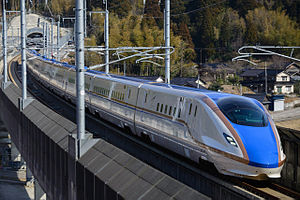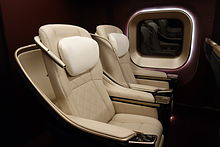Shinkansen series E7
| Shinkansen series E7 | |
|---|---|
|
Class E7 as an Asama connection at the entrance to Ōmiya station
|
|
| Numbering: | F1 - F18 |
| Number: | 18 (216 cars) |
| Manufacturer: | Kawasaki Heavy Industries , Hitachi , J-TREC |
| Year of construction (s): | 2013-2015 |
| Gauge : | 1435 mm ( standard gauge ) |
| Length over coupling: | 26 m (end car) 25 m (middle car) |
| Height: | 3,650 mm |
| Width: | 3,380 mm |
| Top speed: | 260 km / h |
| Continuous output : | 12 MW |
| Acceleration: | 1.6 km / h / s |
| Power system : | 25 kV, 50/60 Hz |
| Power transmission: | Overhead line 2 pantographs |
| Brake: |
Engine brakes , disc brakes |
| Train control : | DS-ATC, RS-ATC |
| Seats: | 934 |
| Classes : | normal (2nd class), green class (1st class), gran class |
| Shinkansen series W7 | |
|---|---|
|
W7 series on the Hokuriku Shinkansen between Shin-Takaoka and Kanazawa
|
|
| Numbering: | W1 - W11 |
| Number: | 11 (132 cars) |
| Manufacturer: | Kawasaki Heavy Industries, Hitachi, Kinki Sharyō |
| Year of construction (s): | 2014-2015 |
| Gauge : | 1435 mm ( standard gauge ) |
| Length over coupling: | 26 m (end car) 25 m (middle car) |
| Height: | 3,650 mm |
| Width: | 3,380 mm |
| Top speed: | 260 km / h |
| Continuous output : | 12 MW |
| Acceleration: | 1.6 km / h / s |
| Power system : | 25 kV, 50/60 Hz |
| Power transmission: | Overhead line 2 pantographs |
| Number of traction motors: | 10 |
| Brake: |
Engine brakes , disc brakes |
| Train control : | DS-ATC, RS-ATC |
| Seats: | 934 |
| Classes : | normal (2nd class), green class (1st class), gran class |
The Shinkansen series E7 ( Japanese 新 幹線 E7 系 電車 , Shinkansen E7-kei densha ) and the Shinkansen series W7 ( Japanese 新 幹線 W7 系 電車 , Shinkansen W7-kei densha ) are two identical Japanese high-speed trains that are designed for use on the Hokuriku Shinkansen can be procured from JR East and JR West .
history
New vehicles had to be procured for the second construction phase of the Hokuriku Shinkansen between Nagano and Kanazawa. On the first construction phase, which has been in operation as the Nagano Shinkansen since 1998 , trains from the N series of the E2 series were used, the oldest trains of which date from the mid-1990s and have been undergoing a general overhaul since the end of 2013. In December 2011, JR East therefore announced that new E7 series vehicles would be procured for the new route. In January 2012, the Kanazawa director of JR West announced that the new vehicles would be jointly developed with JR East. The aim is to receive the trains from the manufacturer a year before the line goes into operation so that the trains can be extensively tested in snow during the winter season.
The first E7 series pre-series train was officially delivered on November 29, 2013 . Before the trains are used on the Hokuriku Shinkansen, they were also tested on the Tōhoku Shinkansen .
The trains of the E7 series have been in service on the Asama connections of the Nagano Shinkansen since March 15, 2014 .
In April 2014, the W1 series W7 pre-series train was delivered to JR West. The delivery was made by Kobe by sea, so that the vehicle had to be reloaded from the ship to low-loaders at the port of Kanazawa in order to be brought to the Hasukan Shinkansen depot. The vehicles were presented to the public for the first time in June 2014.
In April 2015, JR East and JR West announced that they had each ordered an additional set of the E7 and W7 series in order to be able to replace the last E2 series trains on the Asama connection.
technology
Since the E7 / W7 series is to become the immediate successor to the E2 series , their requirement profiles are very similar. Compared to the E2 series, the E7 / W7 series vehicles are said to be more environmentally friendly with higher performance and offer better passenger comfort. As a performance requirement, JR East demanded from the manufacturers that the trains could be operated continuously at 210 km / h even on steep inclines in the mountains. On the new section, the trains are to be operated at a maximum speed of 260 km / h, the technical maximum speed of the trains is 275 km / h.
To minimize noise pollution, the side of the vehicle has been clad with special noise absorbers and a new type of pantograph is used.
Car 12 is equipped with full active suspension so that passengers in the Gran Class can travel particularly comfortably. All other cars are equipped with semi-active suspension.
As with the E5 and E6 series, the E7 / W7 series brake system is supplied by the German manufacturer Knorr-Bremse . In order to meet the requirements of the mountainous route of the Hokuriku Shinkansen, the brakes have to generate up to 600 kW and withstand temperatures of up to 700 ° C.
The E7 / W7 series will be procured as a 12-car formation, making it four cars longer than the E2 series N-series that it will replace. This increases the number of seats from 630 in the E2 series to 934 in the new vehicles.
Train composition
The E7 / W7 series consists of a total of twelve cars, including two non-powered end cars and ten powered intermediate cars. Car 11 is the Green Class (1st class), Car 12 is the Gran Class , which was first introduced in the E5 series.
| direction | ← Tokyo | Kanazawa → | ||||||||||
|---|---|---|---|---|---|---|---|---|---|---|---|---|
| Wagon no. | 1 | 2 | 3 | 4th | 5 | 6th | 7th | 8th | 9 | 10 | 11 | 12 |
| Labelling | Tc | M2 | M1 | M2 | M1 | M2 | M1 | M2 | M1 | M2 | M1s | Tsc |
| Numbering* | E723 | E726-100 | E725 | E726-200 | E725-100 | E726-300 | E725-200 | E726-400 | E725-400 | E726-500 | E715 | E714 |
| Seats | 50 | 100 | 85 | 100 | 85 | 90 | 58 | 100 | 85 | 100 | 63 | 18th |
| Furnishing | Toilets | Toilets, public telephones | Toilets | Wheelchair space, disabled toilet, public telephone | Toilets | Wheelchair space, handicapped accessible toilet | Toilets | |||||
* The cars in the W7 series have numbers analogous to the E7 series, but are listed with a "W" instead of an "E".
The cars 3 and 7 are each equipped with a one-armed pantograph that automatically aligns itself in the direction of travel.
fleet
Series E7
As of July 2015, with the exception of the F18 set that was reordered, all trains have been delivered.
| number | delivery | Manufacturer | Remarks |
|---|---|---|---|
| F1 | November 27, 2013 | Kawasaki HI | Pre-production vehicle |
| F2 | December 26, 2013 | Hitachi | |
| F3 | January 30, 2014 | Hitachi | |
| F4 | February 24, 2014 | Kawasaki HI | |
| F5 | March 18, 2014 | Kawasaki HI | |
| F6 | 2nd June 2014 | Kawasaki HI | |
| F7 | May 14, 2014 | J-TREC | |
| F8 | July 14, 2014 | J-TREC | |
| F9 | August 27, 2014 | J-TREC | |
| F10 | 16th September 2014 | Hitachi | |
| F11 | October 6, 2014 | J-TREC | |
| F12 | November 10, 2014 | J-TREC | |
| F13 | 19th December 2014 | Hitachi | |
| F14 | 19th January 2015 | Hitachi | |
| F15 | February 6, 2015 | Kawasaki HI | |
| F16 | March 2015 | Hitachi | |
| F17 | March 6, 2015 | Kawasaki HI | |
| F18 | October 26, 2015 | J-TREC | Reorder |
W7 series
As of July 2015, with the exception of the W11 set that was reordered, all trains have been delivered.
| number | delivery | Manufacturer | Remarks |
|---|---|---|---|
| W1 | April 30, 2014 | Kawasaki HI | Pre-production vehicle |
| W2 | 5th June 2014 | Hitachi | |
| W3 | June 30, 2014 | Kawasaki HI | |
| W4 | July 18, 2014 | Hitachi | |
| W5 | August 21, 2014 | Kawasaki HI | |
| W6 | September 11, 2014 | Kawasaki HI | |
| W7 | September 27, 2014 | Kinki Sharyo | |
| W8 | 15th October 2014 | Hitachi | |
| W9 | 3rd November 2014 | Hitachi | |
| W10 | December 26, 2014 | Kinki Sharyo | |
| W11 | 17th September 2015 | Hitachi | Reorder |
Web links
Individual evidence
- ↑ Mainichi Shimbun from December 15, 2011: 話題 新 幹線 「E7 系」 開 発 へ ( Memento from July 17, 2012 in the web archive archive.today ) (Japanese)
- ↑ 「大幅 変 更 な し」 七 尾 線 な ど 、 新 幹線 開業 後 も. (No longer available online.) In: The Hokkoku Shimbun. Ishikawa News, Japan January 28, 2012, archived from the original June 18, 2013 ; Retrieved July 1, 2014 (Japanese). Info: The archive link was inserted automatically and has not yet been checked. Please check the original and archive link according to the instructions and then remove this notice.
- ↑ JR East's unveiled first Series E7 high speed train. Railway Gazette, December 2, 2013, accessed July 1, 2014 .
- ↑ Shinkansen tested on Hokuriku line for '15 opening. The Japan Times, December 2, 2013, accessed July 1, 2014 .
- ↑ W7 系 、 30 日 に 石川 初 走 行 白山 車 両 所. (No longer available online.) Ishikawa News, April 24, 2014, archived from the original on August 30, 2014 ; Retrieved July 1, 2014 (Japanese). Info: The archive link was inserted automatically and has not yet been checked. Please check the original and archive link according to the instructions and then remove this notice.
- ^ Expectations high in Ishikawa ahead of the new Shinkansen line. (No longer available online.) Asahi Shimbun, June 23, 2014, archived from the original on July 8, 2014 ; accessed on July 1, 2014 . Info: The archive link was inserted automatically and has not yet been checked. Please check the original and archive link according to the instructions and then remove this notice.
- ↑ Press release of September 20, 2012. Knorr-Bremse AG , September 20, 2012, accessed on July 1, 2014 (English).
- ↑ 北 陸 新 幹線 用 の 新型 車 両 に つ い て. In: press release. JR East, JR West, September 4, 2012, accessed July 1, 2014 (Japanese).
- ↑ E7 系 F7 編成 総 合 車 両 製作 所 出場. RM News, May 22, 2014, accessed July 1, 2014 (Japanese).



